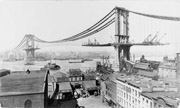Forget its architectural beauty, its iconic shape and how it changed New York forever by binding Manhattan and the mainland. Yes, the Brooklyn Bridge is a wonder that has never been equaled, not by the many bridges built after it -- the Golden Gate Bridge seems, like all things San Francisco compared to New York, a gay younger brother -- nor by any other construction in Brooklyn..
But its importance to the city lies the stories it has provided it with -- living illustrations of the "everything goes" panache of the city.

Steven was the first Brodie born in American soil, after his parents emigrated there from Ireland. In the late 17th century, he was 25 and, according to The New York Times, was "a tall, slim man who looked very much like an overgrown street boy." Which, one assumes, played an important part in the way he transcended to fame.
In 1886, Brodie befriended a Brooklyn bartender called Chuck Connors -- a notorious con man who had found a niche charging visitors for touring with him and hearing his blatant (yet apparently believable) lies and fabrications about the city's history. For color's sake, he included visits to fake opium dens.
However, what Brodie had to offer Connors was much more spectacular -- he waged he would jump right off the Brooklyn Bridge from its tallest point (the mid span) and straight into the East River 135 feet below. If he survived, Connors waged to pay him $200 (roughly $5,000 today).
Connors immediately accepted and, realizing the magnitude of the deal, also summoned a pack of witnesses to behold the feat from the river's shore. He was smart enough to include a reporter from The New York Times for publicity's sake.
They all watched in awe how Brodie kissed his wife goodbye and walked towards the bridge. He disappeared into the distance. He reappeared in the the bridge's mid span a few minutes later. Without much hesitation, he plunged into the void, feet first.
A few minutes of suspense ensued. Connors and the witnesses watched the river's water, which remained still as gelatin. If they had any common sense, they probably assumed Brodie had died. Until he emerged on the shore. His leg hurt, he claimed, and was a bit dizzy. But he had made it.
After such a victory, the $200 were just the tip of the iceberg. With all the witnesses his feat had had, his story would soon spread all over New York. Steven Brodie would go on to become the first New York folk hero.
Posters with his face were pasted in the walls (you can see them yourself at the Library of Congress, with the audacious statement "Champion Bridge Jumper of the World"). Slang expressions were created with his name ("to pull a Brodie" came to signify the achievement of an improbable, flamboyant task). He became rich with the saloon he opened near Grand Street (and he would also get to be more famous for giving away sandwiches to the homeless who stopped by it). He was a New York icon.
Some years after his fame had peaked, it was revealed that he never jumped off the bridge. He had very intelligently conned New York's biggest conman into hiring Brodie's own friends as witnesses of the bet. His friends then proceeded to throw a dummy off the Bridge while he, much more comfortable in a nearby rowboat, waited for the exact moment in which to jump to the water and emerge in plain view while his dummy sank.
History is written in merciless and fickle ink.

What a sight the Brooklyn Bridge must have been to immigrants in the early 20th century. Just as they would arrive to a new, foreign land they would be welcomed by the biggest bridge known to men at the time (the Bear Mountain Bridge, also in the state of New York, would not be completed until twenty years later).
If one could still see under those eyes, one would understandably believe that anything was possible in this country.
And George C. Parker knew what to do with that belief.
Parker was one of the most inspiringly shameless con men in American history. Unlike many others in later years, he understood that the key in his profession is to make the con so outlandishly big that the victims feels it justifies any request no matter who bizarre or excessive.
George C. Parker liked to sell the Brooklyn Bridge. To anyone. He would sell it about twice a week. He had a series of credible-looking documents which gave gullible people (normally clueless immigrants) the impression that he was the legitimate owner of the bridge. Under a series of circumstances, he would add, he had found himself in the obligation to part with his property -- which was a shame because any man controlling the bridge's traffic would make a fortune.
He was so good at his job that the police had to kick several self-proclaimed proprietors out the Bridge and explain to them that it had all been a hoax and that they would have to remove their wooden toll barriers before a car ran over them. He also went down to popular parlance -- "Don't buy the Brooklyn bridge" and "I've got a bridge to sell you" survive to this day as a synonyms for a person's navieté.
As Parker perfected his technique (and even somehow managed to create an office to make his real estate business seem more legitimate) he would also sell other iconic landmarks like Colonel Grant's tomb or the Statue of Liberty.
Since he spawned more than one imitator, the authorities decided to greet immigrants with an informative sign that said "You can't buy public property". Parker's business went down the drain and he would die in Sing Sing prison.
He was probably the only American hero to die there.